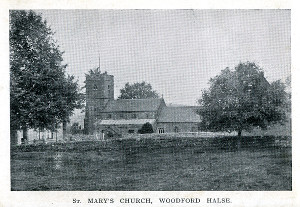Woodford Buildings
St Mary’s
It is assumed, that on the dissolution of many religious houses by Henry VIII, the advowson, that is the right to appoint the incumbent of a parish, was taken by the King and also the rectorial tithes. The advowson was retained by the Crown, it still is, but the rectorial tithes were either sold or given to a friend of the King. At the time of the 18th century enclosure of the land in the parish, the opportunity was taken to commute the tithes, either to land or to money.
Sir John Dryden of Canons Ashby was the lay rector of Woodford Halse, and he was awarded 126 acres for his great tithes and the vicar was awarded 54 acres for his small tithes. At Hinton, Angel Knightley was the lay rector and he got land to the value of ninety pounds per annum and the vicar had to be content with land to the value of eighteen pounds per annum. At West Farndon a different system was employed by the lay rector, William Wheler, he asked for an annual payment of £42 and the vicar was awarded 15 acres. Those figures give some idea of the difference in value of the rector’s income and a vicar’s income. Ownership of the rectorial tithes carried with it the liability to maintain the chancel of the parish church when called upon to do so, and when the tithes were commuted to land that same liability remained, and so, the owner of the land, whoever he may be, bears the responsibility of repairing the chancel and the parishioners the rest of the church.
In 1878 when the whole church was renovated, Sir Henry Dryden, as lay rector of Woodford Halse and Mr. George Hitchcock as lay rector of Hinton, paid for the work done on the chancel and Mr. G.T. Grimsdick, lay rector of West Farndon, contributed to the building fund. Fortunately, major repairs are not called for very often and in these days the church would not be allowed to get into such a state, while still being used. One hundred years ago only local people would be concerned in the upkeep of the fabric of the parish church and there is no doubt that the church had got into a very bad state of repair.
